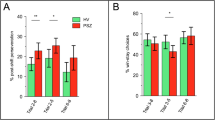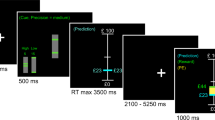Abstract
Rationale and Objectives
Norepinephrine mediates the adjustment of error-driven learning to match the rate of change of the environment, while phasic dopamine signals prediction errors. We tested the hypothesis that pharmacologic manipulation may modulate this process.
Methods
We administered a single dose of methylphenidate, a norepinephrine/dopamine reuptake inhibitor, or placebo in double-blind randomized fashion to 20 healthy human males, who then performed a probabilistic learning task. Each subject was tested in two sessions, receiving methylphenidate in one session and placebo in the other, in randomized order. Task performance was quantified by the percentage of trials on which subjects chose the most likely option, while learning rate was measured using a computational model-based parameter as well as with a behavioral analogue of this parameter.
Results
There was a substance-by-session interaction effect on behavioral learning rate and model-based learning rate, such that subjects receiving methylphenidate exhibited higher learning rates than those receiving placebo in session 1, with no difference observed in session 2, suggesting that subjects retained the increased learning rate across sessions. Higher behavioral learning rate was associated with both higher task performance and with the model-based learning rate. Higher learning rates were advantageous given the high rate of change on the task. Subjects receiving methylphenidate and placebo began the task in session 1 with a similar behavioral learning rate, but those receiving methylphenidate rapidly increased learning rate toward the optimal value, suggesting that methylphenidate accelerated the adaptation of learning rate based on the environment.
Conclusions
The results suggest that methylphenidate may improve disrupted probabilistic learning in disorders involving noradrenergic or dopaminergic dysfunction.


Similar content being viewed by others
References
Aston-Jones G, Cohen JD (2005) An integrative theory of locus coeruleus-norepinephrine function: adaptive gain and optimal performance. Annu Rev Neurosci 28:403–450
Aston-Jones G, Iba M, Clayton E, Rajkowski J, Cohen J (2007) The locus coeruleus and regulation of behavioral flexibility and attention: clinical implications. In: Ordway GA, Schwartz MA, Frazer A (eds) Brain norepinephrine: neurobiology and therapeutics. Cambridge University Press, New York, pp 196–235
Bari A, Aston-Jones G (2013) Atomoxetine modulates spontaneous and sensory-evoked discharge of locus coeruleus noradrenergic neurons. Neuropharmacology 64:53–64
Behrens TEJ, Woolrich MW, Walton ME, Rushworth MFS (2007) Learning the value of information in an uncertain world. Nat Neurosci 10:1214–1221
Browning M, Behrens TE, Jocham G, O'Reilly JX, Bishop SJ (2015) Anxious individuals have difficulty learning the causal statistics of aversive environments. Nat Neurosci 18:590–596
Cazé RD, van der Meer MA (2013) Adaptive properties of differential learning rates for positive and negative outcomes. Biol Cybern 107:711–719
Chowdhury R, Guitart-Masip M, Lambert C, Dayan P, Huys Q, Düzel E, Dolan RJ (2013) Dopamine restores reward prediction errors in old age. Nat Neurosci 16:648–653
Critchley HD, Mathias CJ, Josephs O, O'Doherty J, Zanini S, Dewar BK, Cipolotti L, Shallice T, Dolan RJ (2003) Human cingulate cortex and autonomic control: converging neuroimaging and clinical evidence. Brain 126:2139–2152
Dayan P, Niv Y (2008) Reinforcement learning: the good, the bad and the ugly. Curr Opin Neurobiol 18:185–196
Devilbiss DM, Berridge CW (2006) Low-dose methylphenidate actions on tonic and phasic locus coeruleus discharge. J Pharmacol Exp Ther 319:1327–1335
Dombrovski AY, Clark L, Siegle GJ, Butters MA, Ichikawa N, Sahakian BJ, Szanto K (2010) Reward/punishment reversal learning in older suicide attempters. Am J Psychiatry 167:699–707
Ebitz RB, Platt ML (2015) Neuronal activity in primate dorsal anterior cingulate cortex signals task conflict and predicts adjustments in pupil-linked arousal. Neuron 85:628–640
Etkin A, Egner T, Kalisch R (2011) Emotional processing in anterior cingulate and medial prefrontal cortex. Trends Cogn Sci 15:85–93
Foote SL, Bloom FE, Aston-Jones G (1983) Nucleus locus ceruleus: new evidence of anatomical and physiological specificity. Physiol Rev 63:844–914
Gold JI, Shadlen MN (2000) Representation of a perceptual decision in developing oculomotor commands. Nature 404:390–394
Huys QJ, Pizzagalli DA, Bogdan R, Dayan P (2013) Mapping anhedonia onto reinforcement learning: a behavioural meta-analysis. Biol Mood Anxiety Disord 3:12
Iglesias S, Mathys C, Brodersen KH, Kasper L, Piccirelli M, den Ouden HE, Stephan KE (2013) Hierarchical prediction errors in midbrain and basal forebrain during sensory learning. Neuron 80:519–530
Itoi K, Sugimoto N (2010) The brainstem noradrenergic systems in stress, anxiety and depression. J Neuroendocrinol 22:355–361
Kimko HC, Cross JT, Abernethy DR (1999) Pharmacokinetics and clinical effectiveness of methylphenidate. Clin Pharmacokinet 37:457–470
Korostenskaja M, Kičić D, Kähkönen S (2008) The effect of methylphenidate on auditory information processing in healthy volunteers: a combined EEG/MEG study. Psychopharmacology 197:475–486
Linssen A, Sambeth A, Vuurman E, Riedel W (2014) Cognitive effects of methylphenidate in healthy volunteers: a review of single dose studies. Int J Neuropsychopharmacol 17:961–977
Mathys CD, Lomakina EI, Daunizeau J, Iglesias S, Brodersen KH, Friston KJ, Stephan KE (2014) Uncertainty in perception and the hierarchical Gaussian filter. Front Hum Neurosci 8:825
McAllister TW, Zafonte R, Jain S, Flashman LA, George MS, Grant GA, He F, Lohr JB, Andaluz N, Summerall L (2015) Randomized placebo-controlled trial of methylphenidate or galantamine for persistent emotional and cognitive symptoms associated with PTSD and/or traumatic brain injury. Neuropsychopharmacology 41:1191–1198
Michelson D, Adler L, Spencer T, Reimherr FW, West SA, Allen AJ, Kelsey D, Wernicke J, Dietrich A, Milton D (2003) Atomoxetine in adults with ADHD: two randomized, placebo-controlled studies. Biol Psychiatry 53:112–120
Milad MR, Quirk GJ, Pitman RK, Orr SP, Fischl B, Rauch SL (2007) A role for the human dorsal anterior cingulate cortex in fear expression. Biol Psychiatry 62:1191–1194
Nassar MR, Rumsey KM, Wilson RC, Parikh K, Heasly B, Gold JI (2012) Rational regulation of learning dynamics by pupil-linked arousal systems. Nat Neurosci 15:1040–1046
Nassar MR, Wilson RC, Heasly B, Gold JI (2010) An approximately Bayesian delta-rule model explains the dynamics of belief updating in a changing environment. J Neurosci 30:12366–12378
Pauls AM, O'Daly OG, Rubia K, Riedel WJ, Williams SC, Mehta MA (2012) Methylphenidate effects on prefrontal functioning during attentional-capture and response inhibition. Biol Psychiatry 72:142–149
Payzan-LeNestour E, Dunne S, Bossaerts P, O’Doherty JP (2013) The neural representation of unexpected uncertainty during value-based decision making. Neuron 79:191–201
Rescorla RA, Wagner AR (1972) A theory of Pavlovian conditioning: variations in the effectiveness of reinforcement and nonreinforcement. In: Black AH, Proksasy WF (eds) Classical conditioning II: current research and theory. Appleton-Century Crofts, New York, pp 64–99
Schmid Y, Hysek CM, Simmler LD, Crockett MJ, Quednow BB, Liechti ME (2014) Differential effects of MDMA and methylphenidate on social cognition. J Psychopharmacol 28:847–856
Sullivan GM, Coplan JD, Kent JM, Gorman JM (1999) The noradrenergic system in pathological anxiety: a focus on panic with relevance to generalized anxiety and phobias. Biol Psychiatry 46:1205–1218
Sutton RS, Barto AG (1998) Reinforcement learning: an introduction. MIT Press, Cambridge
Tanaka M, Yoshida M, Emoto H, Ishii H (2000) Noradrenaline systems in the hypothalamus, amygdala and locus coeruleus are involved in the provocation of anxiety: basic studies. Eur J Pharmacol 405:397–406
Volkow ND, Wang G-J, Smith L, Fowler JS, Telang F, Logan J, Tomasi D (2015) Recovery of dopamine transporters with methamphetamine detoxification is not linked to changes in dopamine release. NeuroImage 121:20–28
Yu AJ, Dayan P (2005) Uncertainty, neuromodulation, and attention. Neuron 46:681–692
Yu AJ, Huang H (2014) Maximizing masquerading as matching in human visual search choice behavior. Decision 1:275
Funding
This work was supported by National Institute of Mental Health grant T32 MH018399 to Dr. Howlett and Swiss Foundation for Medical-Biological Grants P3SMP3_155341/1 to Dr. Hysek.
Author information
Authors and Affiliations
Corresponding author
Ethics declarations
Conflict of interest
The authors declare that they have no conflict of interest.
Rights and permissions
About this article
Cite this article
Howlett, J.R., Huang, H., Hysek, C.M. et al. The effect of single-dose methylphenidate on the rate of error-driven learning in healthy males: a randomized controlled trial. Psychopharmacology 234, 3353–3360 (2017). https://doi.org/10.1007/s00213-017-4723-5
Received:
Accepted:
Published:
Issue Date:
DOI: https://doi.org/10.1007/s00213-017-4723-5




